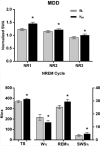Ketamine-Induced Glutamatergic Mechanisms of Sleep and Wakefulness: Insights for Developing Novel Treatments for Disturbed Sleep and Mood
- PMID: 28939975
- PMCID: PMC5866161
- DOI: 10.1007/164_2017_51
Ketamine-Induced Glutamatergic Mechanisms of Sleep and Wakefulness: Insights for Developing Novel Treatments for Disturbed Sleep and Mood
Abstract
Ketamine, a drug with rapid antidepressant effects and well-described effects on slow wave sleep (SWS), is a useful intervention for investigating sleep-wake mechanisms involved in novel therapeutics. The drug rapidly (within minutes to hours) reduces depressive symptoms in individuals with major depressive disorder (MDD) or bipolar disorder (BD), including those with treatment-resistant depression. Ketamine treatment elevates extracellular glutamate in the prefrontal cortex. Glutamate, in turn, plays a critical role as a proximal element in a ketamine-initiated molecular cascade that increases synaptic strength and plasticity, which ultimately results in rapidly improved mood. In MDD, rapid antidepressant response to ketamine is related to decreased waking as well as increased total sleep, SWS, slow wave activity (SWA), and rapid eye movement (REM) sleep. Ketamine also increases brain-derived neurotrophic factor (BDNF) levels. In individuals with MDD, clinical response to ketamine is predicted by low baseline delta sleep ratio, a measure of deficient early night production of SWS. Notably, there are important differences between MDD and BD that may be related to the effects of diagnosis or of mood stabilizers. Consistent with its effects on clock-associated molecules, ketamine alters the timing and amplitude of circadian activity patterns in rapid responders versus non-responders with MDD, suggesting that it affects mood-dependent central neural circuits. Molecular interactions between sleep homeostasis and clock genes may mediate the rapid and durable elements of clinical response to ketamine and its active metabolite.
Keywords: Brain-derived neurotrophic factor (BDNF); Circadian; Major depressive disorder; Neuroplasticity; Slow wave sleep; Suicidality.
Figures


Similar articles
-
Motor-Activity Markers of Circadian Timekeeping Are Related to Ketamine's Rapid Antidepressant Properties.Biol Psychiatry. 2017 Sep 1;82(5):361-369. doi: 10.1016/j.biopsych.2017.03.011. Epub 2017 Mar 28. Biol Psychiatry. 2017. PMID: 28457485 Free PMC article.
-
Concomitant BDNF and sleep slow wave changes indicate ketamine-induced plasticity in major depressive disorder.Int J Neuropsychopharmacol. 2013 Mar;16(2):301-11. doi: 10.1017/S1461145712000545. Epub 2012 Jun 7. Int J Neuropsychopharmacol. 2013. PMID: 22676966 Free PMC article. Clinical Trial.
-
Baseline delta sleep ratio predicts acute ketamine mood response in major depressive disorder.J Affect Disord. 2013 Feb 15;145(1):115-9. doi: 10.1016/j.jad.2012.05.042. Epub 2012 Aug 5. J Affect Disord. 2013. PMID: 22871531 Free PMC article. Clinical Trial.
-
Ketamine, sleep, and depression: current status and new questions.Curr Psychiatry Rep. 2013 Sep;15(9):394. doi: 10.1007/s11920-013-0394-z. Curr Psychiatry Rep. 2013. PMID: 23949569 Free PMC article. Review.
-
Predictors of Response to Ketamine in Treatment Resistant Major Depressive Disorder and Bipolar Disorder.Int J Environ Res Public Health. 2018 Apr 17;15(4):771. doi: 10.3390/ijerph15040771. Int J Environ Res Public Health. 2018. PMID: 29673146 Free PMC article. Review.
Cited by
-
Mood-related central and peripheral clocks.Eur J Neurosci. 2020 Jan;51(1):326-345. doi: 10.1111/ejn.14253. Epub 2018 Nov 29. Eur J Neurosci. 2020. PMID: 30402924 Free PMC article. Review.
-
Sleep alterations in treatment-resistant depression patients undergoing ketamine treatment.Pharmacol Rep. 2024 Dec;76(6):1325-1332. doi: 10.1007/s43440-024-00641-1. Epub 2024 Aug 29. Pharmacol Rep. 2024. PMID: 39207673 Free PMC article.
-
Neurobiological biomarkers of response to ketamine.Adv Pharmacol. 2020;89:195-235. doi: 10.1016/bs.apha.2020.05.003. Epub 2020 Jun 18. Adv Pharmacol. 2020. PMID: 32616207 Free PMC article. Review.
-
Ketamine as an antidepressant: overview of its mechanisms of action and potential predictive biomarkers.Ther Adv Psychopharmacol. 2020 May 11;10:2045125320916657. doi: 10.1177/2045125320916657. eCollection 2020. Ther Adv Psychopharmacol. 2020. PMID: 32440333 Free PMC article.
-
Improving Sleep in Intensive Care Unit: An Overview of Diagnostic and Therapeutic Options.J Patient Exp. 2020 Oct;7(5):697-702. doi: 10.1177/2374373519882234. Epub 2019 Oct 17. J Patient Exp. 2020. PMID: 33294603 Free PMC article.
References
MeSH terms
Substances
Grants and funding
LinkOut - more resources
Full Text Sources
Other Literature Sources
Medical

